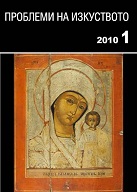„Святители – источники премудрости” во фресках Спасо-Преображенской церкви Евфросиньева монастыря в Полоцке
„The Sources of Wisdom of Saint Bishops” in the Murals of the Transfiguration Church of the Evfrosiniev Monastery in Polotsk
Author(s): Vladimir SarabianovSubject(s): Cultural history
Published by: Институт за изследване на изкуствата, Българска академия на науките
Summary/Abstract: Among the frescoes of the middle 12th c. (ca. 1161) which were recovered in the last few years in the Transfiguration church of the Evfrosiniev monastery in Polotsk, two partly conserved compositions on the theme of „The Heavenly Wisdom of Saint Bishops” have been recently cleaned. Both scenes are situated in the lower part of south and north walls of the main part of the church. The composition on the south wall illustrates the subject from the Vita of St. john Chrysostom which is known as „The Vision of Proclus”. john Chrysostom is seating in the centre of the composition while Apostle Paul is standing behind him whispering the words of the Heavenly Wisdom into his ears, and Proclus – the secretary of john – is watching the scene through the curtain door. The new detail of this iconography is the spring of water which comes from under the desk of john Chrysostom and symbolizes the Source of Wisdom. A few monks are standing in front of the saint, two others drink water from the spring. This detail which gives a new symbolic sense to the whole composition appears in the iconography of the subject only in the second part of the 12th c. (Ambrosian. I 72 sup. (65), fol. 263 v), and the fresco of the Polotsk church seems to be the earliest example of the new iconography. The composition of the opposite north wall has a mirror-like structure and is dedicated to Gregory of Nazianzus. It repeats all the details of the previous scene, includ- ing the group of monks and even the figure of spectator in the curtain door. The only difference is a figure of inspirer, who is now john the Theologian. The Vita of Gregory the Nazianzus doesn’t say a word about the vision of john the Theologian to the saint, and the presence of both apostle and spec- tator in the subject is an arbitrary adoption of the artist, who copied the scheme of the composition with john Chrysostom for the purpose of symbolic extension of the frescoes iconographic program. Both compositions compose a complex iconographic program that has analogues only in late Byzantine and Post-Byzantine murals of Lesnovo (1349), Poganovo (1499) and Pherapontov monastery (1502), where the same subjects occupy the surface in the upper part of the church under the dome. But in the Polotsk church both compositions are situated in the lower register of the decoration and can be interpreted in other contexts. The lower part of decoration of the Polotsk church is dedicated to the wide monastic program with numerous depictions of monks and nuns, stylites and hermits, and also a whole cycle of scenes from the life of Antony the Great and other saint monks.
Journal: Проблеми на изкуството
- Issue Year: 2010
- Issue No: 1
- Page Range: 12-17
- Page Count: 6
- Language: Russian
- Content File-PDF

